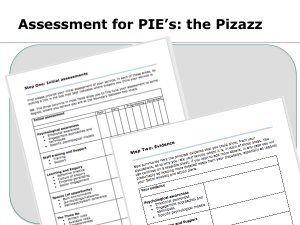Using PIEs 1 with Pizazz
The Pizazz was designed to work best with the PIEs 2.0 formulation of a PIE. This was, at least in part, because PIEs 2.0 was originally designed explicitly with the intention for a more evidence-based assessment approach in mind, with specifics of observable practice. The older 'classic' version was more inspirational, and does not work so well as a framework for evidence.
PIEs 1 is also more restricted in its range, as it was originally formulated principally for accommodation-based services, and principally for homelessness. As a consequence the focus on systemic issues is less well articulated (See: 'A single framework?': HERE).
Nevertheless, it should be possible to use the Pizazz with the older account. All but one of the same issues and concepts are included within PIEs 2, and all past training or development work undertaken using the older model will find it has a place in the 2.0 framework.
Relationships and reflective practice
Reflective practice, always seen as the golden road to developing as a PIE, is included in PIEs 2, but as one aspect of a rather bigger picture - the attitude of the agency to learning from experience, which ideally should percolate and be embedded throughout the service. ( See the discussion on 'Top to toe embedding' in the forums pages, HERE) .
Of the main core elements in the classic model, the only area that does NOT appear explicitly in the PIEs 2 formulation is the centrality of relationships. ( See 'Relationships in PIEs 2' : HERE)
Since that is central to everything, you will find that you touch on it everywhere, or anywhere. But for services that are particularly keen to retain a central focus on relationships, it is quite easy to customise, and simply add another sheet to the Pizazz on paper.
You can then summarise there, in one place, all the more specific operational practices that will appear in other areas. (Much of it belongs, in practical terms, in 'the Three Rs'). Duplication here is not a problem.
When the Pizazz is used primarily for assessment and development within one team or service, small adjustments to accommodate PIEs 1 can often still be quite sufficient - depending on the service. You should find that some of the things that were missing, or had seemed awkward or confusing in PIEs 1 are more clearly laid out in the new model.
It is where the Pizazz is to be used in a larger service or a network, where comparability becomes important, that greater care must then be taken over consistency. (See 'The PIE Abacus with services using PIEs1: HERE)
The two formats (1) The Pizazz on paper
As the Pizazz now comes in two formats - the 'pen and paper' format, and the electronic/on-line format known as the PIE Abacus. - working with the Pizazz and PIEs 1 needs a different treatment in each format.
The 'pen and paper' format is suitable for simpler and smaller services, where getting round a table to meet and discuss face-to-face is an option; and/or perhaps to those still fairly new to the PIE approach, or those not familiar yet with PIEs 2.0..
Here, teams can simply include and extra sheet, to record all the items and issues that relate to relationships, and are spelled out in practical terms in other fields. The overview that this provides seems helpful to some.
The two formats (1) The PIE Abacus
The electronic/on-line format ( the "PIE Abacus') is geared for more complex and/or larger services, organisations and networks, where face-to-face meeting is impractical. The Abacus is designed to meet the needs of larger services and systems, needing an overview of multiple services; and as software, it has some powerful analytical features.
Another of the advantages of the PIE Abacus is its relative flexibility. It will even be possible to create adapted versions of the PIE Abacus to work with PIEs 1. PIEs 2 will still be there, in the background, to be brought into play when ready. ( See: Customising your PIE Abacus : HERE)
Further background reading/listening/viewing
The full paperwork


The basic Pizazz assessment summary sheets : HERE
The Pizazz Handbook, 'Useful questions' : HERE
Pizazz assessment levels guidance : HERE
Advice for Pizazz assessment facilitators : HERE
Creative Commons licence terms : HERE
For the PIE Abacus, see: The PIE Abacus - an online Pizazz
See: Which form of the Pizazz is right for our service?
How come its free? (PIElink page) HERE
PIEs 2.0 - the development process (PIElink page) HERE
The simplest, most effective way to evaluate and improve your PIE from Daniel O'Brien on Vimeo.
